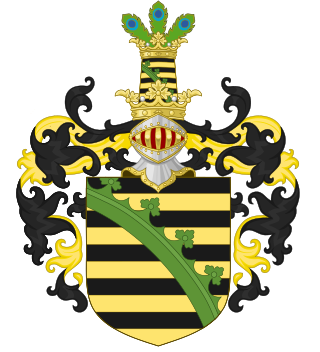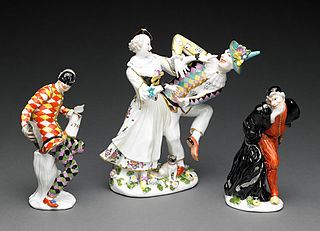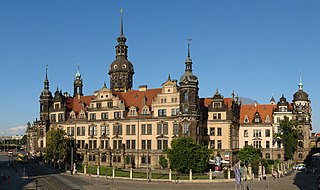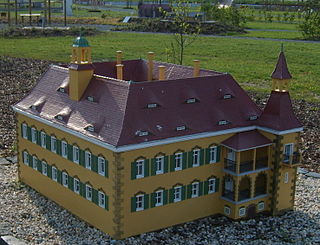The House of Ascania was a dynasty of German rulers. It is also known as the House of Anhalt, which refers to its longest-held possession, Anhalt.

Meissen is a town of approximately 30,000 about 25 km (16 mi) northwest of Dresden on both banks of the Elbe river in the Free State of Saxony, in eastern Germany. Meissen is the home of Meissen porcelain, the Albrechtsburg castle, the Gothic Meissen Cathedral and the Meissen Frauenkirche. The Große Kreisstadt is the capital of the Meissen district.

Wettin is a small town belonging to the municipality of Wettin-Löbejün in the Saale District of Saxony-Anhalt (Saxony-Ascania), Germany. It is situated on the River Saale, just north of Halle. It is known for Wettin Castle, the ancestral seat of the House of Wettin, the former ruling dynasty of Saxony, Poland, the United Kingdom, Belgium, and Bulgaria. The town and its name are of Slavic origin.

Königstein Fortress, the "Saxon Bastille", is a hilltop fortress near Dresden, in Saxon Switzerland, Germany, above the town of Königstein on the left bank of the River Elbe. It is one of the largest hilltop fortifications in Europe and sits atop the table hill of the same name.

The House of Wettin was a dynasty of German kings, prince-electors, dukes, and counts that once ruled territories in the present-day German states of Saxony, Saxony-Anhalt and Thuringia. The dynasty is one of the oldest in Europe, and its origins can be traced back to the town of Wettin, Saxony-Anhalt. The Wettins gradually rose to power within the Holy Roman Empire. Members of the family became the rulers of several medieval states, starting with the Saxon Eastern March in 1030. Other states they gained were Meissen in 1089, Thuringia in 1263, and Saxony in 1423. These areas cover large parts of Central Germany as a cultural area of Germany.

The Albrechtsburg is a Late Gothic castle erected from 1471 till about 1495. It is located in the town centre of Meissen in the German state of Saxony. It is situated on a hill above the river Elbe, adjacent to the Meissen Cathedral.

Meissen porcelain or Meissen china was the first European hard-paste porcelain. Early experiments were done in 1708 by Ehrenfried Walther von Tschirnhaus. After his death that October, Johann Friedrich Böttger continued von Tschirnhaus's work and brought this type of porcelain to the market, financed by Augustus the Strong, King of Poland and Elector of Saxony. The production of porcelain in the royal factory at Meissen, near Dresden, started in 1710 and attracted artists and artisans to establish, arguably, the most famous porcelain manufacturer known throughout the world. Its signature logo, the crossed swords, was introduced in 1720 to protect its production; the mark of the swords is reportedly one of the oldest trademarks in existence.

The Margravate or Margraviate of Meissen was a medieval principality in the area of the modern German state of Saxony. It originally was a frontier march of the Holy Roman Empire, created out of the vast Marca Geronis in 965. Under the rule of the Wettin dynasty, the margravate finally merged with the former Duchy of Saxe-Wittenberg into the Saxon Electorate by 1423.

Dresden Castle or Royal Palace is one of the oldest buildings in Dresden, Germany. For almost 400 years, it was the residence of the electors (1547–1806) and kings (1806–1918) of Saxony from the Albertine House of Wettin as well as Kings of Poland (1697–1763). It is known for the different architectural styles employed, from Baroque to Neo-renaissance.

Dahlen Castle is a castle built between 1744 and 1751 in the small town of Dahlen, located in Saxony, Germany.

The Military Order of St. Henry was a military order of the Kingdom of Saxony, a member state of the German Empire. The order was the oldest military order of the states of the German Empire. It was founded on October 7, 1736 by Augustus III, King of Poland and Elector of Saxony. The order underwent several more revisions over the course of the 19th and early 20th centuries. It became obsolete with the fall of the Saxon monarchy in the wake of Germany's defeat in World War I.

Wernigerode Castle is a schloss located in the Harz mountains above the town of Wernigerode in Saxony-Anhalt, Germany. The present-day building, finished in the late 19th century, is similar in style to Schloss Neuschwanstein, though its foundations are much older and have been reconstructed several times. Wernigerode Castle was first built at the beginning of the 12th century (1110-1120) as a Romanesque architecture medieval fortress for German emperors to have a secure spot to stop during their hunting trips to the Harz. Few of these medieval walls and foundation remain today. At the end of the 15th century the castle was enlarged in a Gothic architecturestyle, with large arched windows. During the 16th century, it was rebuilt as a Renaissance fortress. A spiral staircase tower still remains intact today.

Fallersleben Castle is located in Wolfsburg in the German state of Lower Saxony and, together with Neuhaus and Wolfsburg Castles, is one of the most important historic buildings in the town. It is in the district of Fallersleben and forms an historic setting along with the castle lake, St. Michael's Church and the Old Brewery.

Rochsburg Castle, which was probably founded in the late 12th century, stands on a rock spur, surrounded on three sides by the Zwickau Mulde river, above the eponymous town quarter in Lunzenau in Saxony. The medieval site and its division into the inner bailey, outer bailey and two zwingers is still easy to recognise. In its present appearance the schloss dates, however, to the Late Gothic and Renaissance periods. Its main construction phases date to 1470 and 1548; it is an important example of Renaissance architecture in Saxony. Over centuries the Rochsburg has formed the centrepiece in the Saxon district of Rochsburg.

Schloss Weesenstein is a Schloss located in Weesenstein, a small village, part of Müglitztal in the Müglitz river valley, around 3 kilometres (1.9 mi) south of Dohna in Saxony, Germany.

Mildenstein Castle, in German Burg Mildenstein, also called Schloss Leisnig, is located in Leisnig in Landkreis Mittelsachsen, Saxony, Germany. It is a property of the Free State of Saxony and is administrated by the company State Palaces, Castles and Gardens of Saxony.
The New Uhyst Castle is located on the northern edge of the town of Uhyst in the Saxony district of Görlitz, Germany. It is located near the Spree river flowing through the village and borders the Bärwalder See Landscape Park. The castle grounds have a Baroque garden and an English landscape park.

The remains of Saathain Castle and its former manor are situated on the left bank of the Black Elster River in Saathain, which is a district within the southern Brandenburg municipality of Röderland. Following a devastating fire in April 1945, the historic structure was reduced to its foundation walls. These remnants now support a terrace that was once a café. The park that once surrounded the castle has been transformed into a beautiful rose garden, making it a favored destination for excursions.
Carl Borromäus von Miltitz was a German poet, composer, and writer.






















